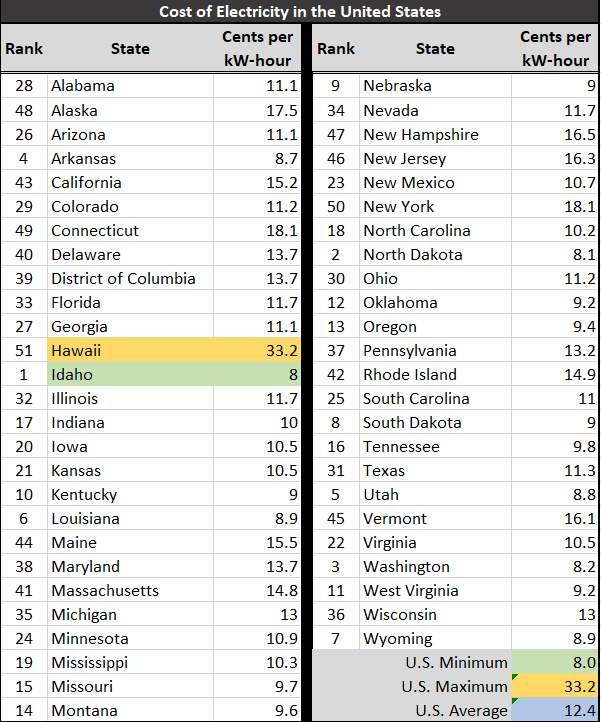Cost of Electricity Info
Tags | |
UUID | f73576a7-5ee4-11ef-98f1-bc764e203090 |
The Cost of Electricity
The cost of electricity in different states is influenced by a combination of factors, including:
- Fuel Costs
- Type of Fuel: States that rely heavily on natural gas, coal, or renewable sources like wind, solar, or hydroelectric power may experience different costs depending on the availability and price of these fuels.
- Fuel Availability: Regions closer to fuel sources generally have lower transportation costs, which can lead to lower electricity prices.

- Energy Mix
- Renewable Energy: States with significant investments in renewable energy sources may have lower or higher costs depending on the subsidies, infrastructure costs, and efficiency of these sources.
- Nuclear Energy: States with nuclear power plants might have stable but relatively high upfront costs, leading to long-term stable pricing.
- Infrastructure
- Transmission and Distribution Costs: The cost to build, maintain, and upgrade the grid infrastructure varies. States with extensive or outdated grids may have higher costs.
- Geography: Remote or mountainous regions may face higher costs to build and maintain infrastructure.
- Regulatory Environment
- State Regulations: Some states have deregulated electricity markets where competition can drive prices down, while others have regulated markets where prices are set by utility commissions.
- Environmental Regulations: States with strict environmental regulations may have higher costs due to the need to comply with emissions standards or invest in cleaner technologies.
- Demand
- Population and Industrial Demand: States with higher demand due to population density, industrial activity, or extreme weather conditions (requiring heating or cooling) may have higher electricity costs.
- Peak Demand: States that experience high peak demand may face higher costs if additional, often more expensive, generation capacity is required to meet those peaks.
- Market Conditions
- Wholesale Electricity Prices: These are influenced by supply and demand dynamics, fuel costs, and market regulations. States participating in regional electricity markets might experience different prices based on market trends.
- Competition: In deregulated states, competition among electricity providers can influence prices.
- Taxes and Fees
- State Taxes: Some states impose additional taxes on electricity, which can increase the overall cost to consumers.
- Utility Fees: Utility companies may charge additional fees for grid maintenance, renewable energy programs, or other services.
- Weather and Climate
- Climate: States with extreme climates may have higher costs due to increased demand for heating or cooling.
- Natural Disasters: Regions prone to hurricanes, wildfires, or other natural disasters might face higher costs due to the need for more resilient infrastructure.
- Economic Conditions
- Economic Growth: High economic activity can drive up demand, affecting prices.
- Subsidies and Incentives: Government subsidies for certain types of energy production can lower costs, while the lack of incentives can result in higher costs.
Each of these factors can interact in complex ways, leading to significant variations in electricity prices across different states.
This Wikiclip is used in the following pages:
- Comments
- Attachments
No comments |
This site uses cookies to give you the best, most relevant experience. By continuing to browse the site you are agreeing to our use of cookies.
